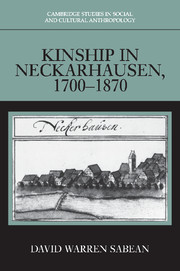Book contents
- Frontmatter
- Contents
- List of tables
- Abbreviations
- Abbreviations of sources
- On reading kinship diagrams
- Glossary
- Preface
- Introduction
- Cohort I (1700–1709)
- Cohort II (1740–1749)
- Cohort III (1780–1789)
- Cohort IV (1820–1829)
- 15 Kinship at the beginning of the nineteenth century
- 16 Kinship and practice at the turn of the century
- Cohort V (1860–1869)
- Conclusion
- Appendix
- Bibliography
- General index
- Index of villagers
15 - Kinship at the beginning of the nineteenth century
Published online by Cambridge University Press: 04 August 2010
- Frontmatter
- Contents
- List of tables
- Abbreviations
- Abbreviations of sources
- On reading kinship diagrams
- Glossary
- Preface
- Introduction
- Cohort I (1700–1709)
- Cohort II (1740–1749)
- Cohort III (1780–1789)
- Cohort IV (1820–1829)
- 15 Kinship at the beginning of the nineteenth century
- 16 Kinship and practice at the turn of the century
- Cohort V (1860–1869)
- Conclusion
- Appendix
- Bibliography
- General index
- Index of villagers
Summary
Many people who commented on Württemberg – and indeed on Germany as a whole – during the first several decades of the nineteenth century drew attention to increasing pauperization and a widening split between those with enough resources to maintain independence and those involved in a desperate search for occasional sources of income. By 1828 the Neckarhausen pastor was expressing concern about the poor in the village outnumbering the propertied, and other observers were beginning to speak longingly of an earlier prosperity, visible still in the last generation. Until the 1820s, the older stratification system maintained its fundamental characteristics under the stress of an expanding population. Wealthy peasants extended political domination, and a growing underclass of farm laborers, village servants, and impoverished artisans found new niches for themselves in a “makeshift economy.” Although the village population rose from 516 to 738, or 43 percent, between the 1780s and 1820s, the proportion of independent agricultural producers – Bauern – declined from 36 percent to 24 percent, from well over a third to just under a quarter. By the end of the eighteenth century, the average artisan held only 40 percent as much property as the average Bauer, which amounted to a considerable decline throughout the century from an earlier figure of 75 percent. Individuals from the burgeoning group of farm laborers owned only 20 percent as much real estate as a typical Bauer.
- Type
- Chapter
- Information
- Kinship in Neckarhausen, 1700–1870 , pp. 262 - 292Publisher: Cambridge University PressPrint publication year: 1997



